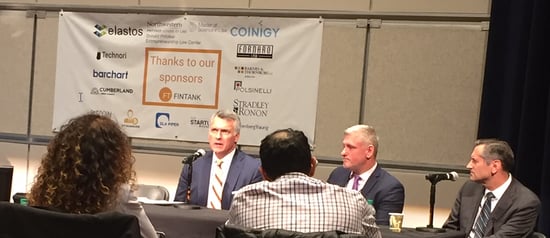
Crypto Markets Are Young, Hungry and Just Getting Started

It’s not uncommon to hear people in the cryptocurrency space say the market and the industry itself reminds them of the internet before it became THE Internet. What that means is open to interpretation but for many in the crypto and blockchain space, we are in the early stages of a transformative currency and technology with work and opportunity ahead we may not even imagine.
From a market standpoint, the crypto trading space today stands somewhere between the wild, wild, west and an infrastructure project that is months, maybe a few years, from becoming a fully integrated asset class. And from the vantage of someone in the crypto space, Wall Street, LaSalle Street and every other mainstream financial industry will eventually be pulled in, passed up, or circumvented by it.
At the February 15th CryptoCon event in Chicago by FinTank, everyone from exchanges, brokers, market makers, traders and investors spoke about this market in ways that exhibit curiosity and possibility. Jim Radecki, Global Head of Business Development for Cumberland, the crypto mining and trading arm of DRW, said institutional firms are entering the cash and futures markets while others await more financial infrastructure.
“There is an institutional wall of money lining up and that’s how you know this is becoming mainstream as an asset class, and it keeps creeping closer and closer,” Radecki said.
Challenges in Today’s Crypto Currency Markets
He said in 2017, about 25 hedge funds launched crypto-based funds, and by the end of the year there were about 75 more. In 2018, there are another 150 more in various forms of development. Radecki added “What we’re seeing is traditional capital markets players come to the table and ask a lot more questions and understand what the barriers to entry are.”
There are a number of challenges for the crypto markets today, including the maturity of the cash markets themselves. As many were set up as exchanges for buyers and sellers, and have grown in size, they are currently inferior in terms of their technology and robustness to established futures or equities platforms, which can handle large volumes of high speed trades in microseconds. For institutional firms looking to create funds, there still aren’t any qualified custodial services. There also aren’t any established insurers or re-insurers for eWallets, and the US FDIC doesn’t appear interested.
As Radecki pointed out, this is the only asset class in our lifetimes that has launched and outgrown its infrastructure. So, what we’re beginning to see are traditional infrastructure players getting involved. Last month, Trading Technologies announced it will connect its trading infrastructure to Coinbase’s GDAX cash market for cryptocurrencies. It will likely do so with other cash markets as well. What that means is, professional grade trading software and its institutional trading base will be able to trade on the spot crypto markets. That pipeline is one big step that other independent software vendors will surely follow if this market continues to grow. Of course, the December launches of bitcoin futures on the Cboe Futures Exchange and CME Group Exchange were milestones which add a solid foundation for hedging and speculating in these markets.

Bob Fitzsimmons of Wedbush Securities discusses cryptocurrencies at the FinTank CryptoCon event in Chicago.
Bob Fitzsimmons, Managing Director of Wedbush Securities and head of Wedbush Futures, said in an interview with John Lothian News that the ecosystem of speculators and hedgers is beginning to take shape in the futures markets. More customers are finding comfort there with regulated markets, battle-tested trading platforms and a clearing house that backs up every trade. There is also the convenience and familiarity of keeping transactions in dollars, rather than bitcoin or other cryptocurrencies.
“So the customers we are having conversations with say, “If we’re going to go short, I’d rather do it on the CME or CFE, cleared by CME or OCC, and have my money in dollars,” he said. “So even in a worst case, if somebody steals an eWallet or somebody crashes an exchange, I am short over here in futures and I get my dollars out.”
Growth of ICO’s and Other Cryptocurrencies
We are still in the infancy of so-called initial coin offerings, but there is no lack in the demand for information about them. ICOs represent some interesting and innovative ways for firms to raise capital without the assistance of Wall Street. That should make traditional stock exchanges and investment banks nervous, or perhaps excited if they find ways to join that space. But ICOs are also laden with regulatory landmines. As several attorneys at CryptoCon pointed out, the US Securities and Exchange Commission considers ICO tokens as securities. Richard Levin, an attorney with Polsinelli, told the audience that SEC Chairman Jay Clayton has sent a serious and loud message to the market on tokens – they are securities and will be regulated as such. And that lends a whole new level of complexity and compliance to ICOs. Meanwhile, the Commodity Futures Trading Commission has viewed bitcoin as a commodity, which lends a whole new level of confusion to the market. In short, regulation is another aspect of this marketplace that needs to be clarified and developed.
When panelists were asked where we are in the development of this space – be it cryptocurrencies, blockchain, ICO, investment funds and trading infrastructure, the answer usually was – we’re not even in the first inning.
Better start warming up.
—
Related posts:
Editor’s Picks
Many people are skeptical or even afraid of Artificial Intelligence (AI). But we've been using it to enhance our team and capabilities. The real...


Connect with us to discover how we can help your business grow.
.jpg)
